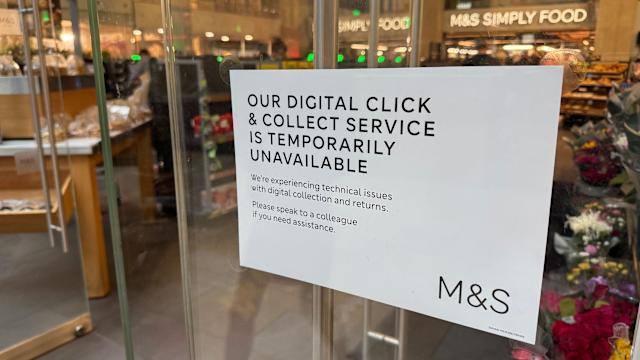A Cyber Wake-Up Call in Global Retail
In a striking reminder of how vulnerable even the biggest corporations remain in the face of digital threats, Marks & Spencer has reportedly suffered a large-scale cyberattack with potential losses estimated at £206 billion (Rp66 trillion or roughly $4 billion). As one of the UK’s oldest and most recognized retailers, the Marks & Spencer cyberattack isn’t just a company-specific incident—it’s a wake-up call to the entire global retail industry.
This article delves deep into the origins of the attack, its financial and operational impacts, the response from the company, and the broader implications for retail cybersecurity across the globe.
The Attack: What Happened?
The incident occurred in mid-May 2025 and is believed to have been carried out by the infamous Scattered Spider hacking group, known for targeting major corporate infrastructures. Early reports suggest that the attackers breached Marks & Spencer’s digital ecosystem through a third-party vendor—once again exposing how weak external integrations can act as a gateway for internal disasters.
Once inside, the attackers are believed to have gained unauthorized access to sensitive customer and operational data, including potential vulnerabilities in payment gateways and logistics systems. The breach went undetected for several hours—long enough to cause serious disruptions.
While Marks & Spencer has not released detailed technical findings, cybersecurity analysts suspect that social engineering tactics combined with malware injections were used to execute the breach.
Financial Fallout: £206 Billion in Potential Losses
Marks & Spencer’s stock price tumbled after the news broke, reflecting investor anxiety over the magnitude of the breach. Initial financial modeling by cybersecurity risk firms suggests that the company could face direct and indirect losses of up to £206 billion, driven by several factors:
- Operational Downtime: Temporary shutdowns of online platforms, warehousing, and logistics.
- Regulatory Penalties: Potential fines from the UK Information Commissioner’s Office (ICO) under GDPR.
- Customer Lawsuits: Breach of trust could lead to class-action lawsuits by affected users.
- Brand Damage: Declining customer confidence impacting future revenue streams.
Additionally, retail insiders believe that Marks & Spencer could face delayed shipments, disrupted international supply chains, and increased insurance premiums—further adding to the already staggering potential loss figure.
The Response: Immediate Measures and Future Plans
Upon detecting the breach, Marks & Spencer activated its cybersecurity incident response plan, including cooperation with law enforcement agencies like the UK’s National Cyber Security Centre (NCSC) and private forensics firms. Public statements from the company confirmed the attack but emphasized that the situation was under control and efforts were ongoing to strengthen defenses.
Key measures taken include:
- Temporary suspension of affected systems
- Prompt communication with affected users
- Engagement with cybersecurity experts
- Patching known vulnerabilities across platforms
- Reviewing all third-party software and access protocols
Moreover, Marks & Spencer promised to increase its cybersecurity budget and implement AI-powered monitoring systems to proactively detect anomalies in real-time moving forward.
A Wider Industry Problem: Retailers in the Crosshairs
The Marks & Spencer cyberattack is not an isolated case. Retailers worldwide are increasingly becoming prime targets for cybercriminals. Why? Because they possess exactly what hackers want: rich consumer data, payment gateways, and interconnected systems vulnerable to third-party access points.
In recent years, major retailers like Target, Macy’s, and even Amazon have all faced cybersecurity incidents. The common thread across these attacks often lies in:
- Third-party supply chain vulnerabilities
- Lack of employee cybersecurity training
- Outdated infrastructure not built for today’s threat levels
This suggests that the retail sector needs a major cybersecurity overhaul, especially as the industry becomes more digitally driven. From e-commerce to supply chain software, every touchpoint is a potential attack surface.
Lessons Learned: What Businesses Should Do Now
What makes this cyberattack particularly devastating is that it was preventable, had stricter protocols been enforced. Here’s what businesses—especially those in retail—must take away from the Marks & Spencer crisis:
- Zero Trust Architecture: Adopt a security model that assumes no one, internal or external, is trustworthy by default.
- Vendor Risk Management: Create strict onboarding processes and regular audits for third-party vendors.
- Employee Awareness Programs: Invest in regular training on phishing, password hygiene, and incident reporting.
- Cyber Insurance: Ensure comprehensive cyber liability coverage is in place to mitigate post-breach fallout.
- Regulatory Compliance: Maintain GDPR, PCI DSS, and other data protection frameworks rigorously.
Cybersecurity is no longer an IT function—it is a core business priority.
Conclusion: Cybersecurity Must Be a Retail Imperative
The Marks & Spencer cyberattack is a sobering reminder that even legacy brands with deep pockets and robust infrastructure are not immune to today’s digital threats. As cyberattacks become more targeted, more coordinated, and more expensive, retailers need to shift from reactive to proactive security strategies.
Whether it’s investing in cutting-edge technology, upskilling employees, or vetting third-party integrations, the cost of prevention is far less than the cost of a breach. If retailers don’t treat cybersecurity as a critical pillar of their business model, they may find themselves the next cautionary tale in a growing list of high-profile cyber disasters.
Read More






 Friday, 05-12-25
Friday, 05-12-25







